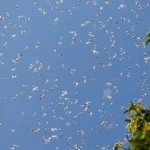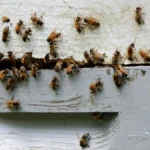In spring I often get calls from people with bees in their cars. So let’s ask “Why do bees swarm cars?” and how can we stop this rather irritating thing from happening. Understanding bees and how to stop them from being a nuisance is simple and easy if you know the tricks.
Every year in spring I used to get phone calls from a junkyard and a military base. The call always went about the same way – “Hi, there are bees in a car/jeep/truck/ambulance parked in our lot”. To understand what went wrong we need to ask a few questions.
What Happens When Bees Swarm?
Bees swarm when they have an opportunity to move some or all of the bees in a hive to a new hive. This is how beehives reproduce. Sometimes in spring, a single hive can produce as many as 10 swarms – this is common for African honey bees. Swarms go and look for new places to live, and these new places become new hives.
A swarm looks for a nice spot that has good insulation from the wind, is easy to find, and is a bit off the ground. For more on swarms read here.
Why Do Bees Swarm Cars?
If you look at the above description of nesting sites, this is a lot like the description of a car!! If you leave the car window slightly open, it is the perfect nesting spot for a swarm of bees. Well, they will think so – you will disagree with them a bit about this, but they have 5000-10000 stings and you don’t, so they will temporarily win this argument. Bees swarm cars because cars are comfortable and bees like comfortable places. This is also why they swarm into our houses. We have similar desires for comfort in life to bees.
So why do bees swarm cars? Mainly because people leave windows open.
Do Yellow Cars Attract Bees?
Why do bees swarm cars? It has nothing to do with the color! Lighter color cars are less hot – so in certain conditions, lighter colored cars will be attractive to swarms (read a hot climate like Florida) and in other environments, a darker car will be warm and cozy in a cold climate (read the northern USA, Canada in spring). There will however be no specific reason that bees would prefer a yellow car.
Why Is Bee Swarming A Problem?
Bee swarming much like human migration causes feelings of resentment to creatures living in an area where the bees were absent before. A beehive is a colony – when they move, they take over.
Much like humans colonizing countries and invading other countries this sort of thing stirs up emotions in the space of the creature being colonized. If your car gets invaded by bees, while you are sitting in it, you will understand more clearly why any group of people who have experienced a colonial or invasion event tend to be a bit jumpy about this.
I am a beekeeper – I love it when bees swarm because I catch the swarms and put them in boxes and the swarms make honey for me. So for me, bee swarms are great. However, for somebody else, this perception may be a bit different if they are just chilling in their car drinking coffee and a swarm moves in.
Bees In The Car
This is a very different problem to our main question “why do bees swarm cars?” A major cause of road accidents is people trying to get single bees (not swarms) and yellow jackets out of their cars. Many people like to drive with a window slightly open. This has the effect of creating a series of pressure zones, some of which create a suction into the vehicle.
If you drive along a highway and there is a beehive on one side of the road and a field of flowers on the other, there will be a constant flow of bees over the highway. Sometimes a bee will get caught in the turbulence of the vehicle and get sucked into the car. It will then buzz around inside and make a general nuisance of itself.
To save this bee, pull over to the side of the road. Open the windows – it will most likely fly out. It will not leave the car easily unless you stop. Bees can only find their way home if they are a few miles from their hive, so the further you drive trying to get the bee out the greater the chance YOU and THE BEE will die. Next time you try to get a bee out of the car while driving watch how you swerve all over and you will see I am right.
Why Do Bees Swarm Cars? (The End Of The Story)
You may remember we started this adventure with me receiving calls every spring during the swarming season from the military base and the junkyard. Both were because bees had moved into cars/tanks/armored vehicles/jeeps/ambulances and one aircraft. I solved the problem – for the military base – but not the junkyard. I told them, eventually, to close their windows. You see, it is standard practice to leave vehicles parked in the sun with the windows a crack open – this stops the inside overheating and extends the life of the seats and plastic interior components. It however also leaves a little gap open for bees to move in.

Read more about: Who To Call For A Beehive Removal
So if they close the windows, they shorten the vehicle life….there is a new solution to this! Read on.
Why Do Bees Swarm Cars – and How Do We Solve This Problem?
Keep the windows closed when you store your car. Or you can insert one of these.

If the bees cannot get into your car, they will not swarm into it. This is the simplest way to solve the problem.
Why do bees swarm cars? Well, now you know! Cars are nice to be in. And they share our tastes for comfort. Unlike us, bees do not know how to open windows, so if you want to keep them from swarming into your car, keep the windows closed! If you enjoyed this please share.
Bee Swarm on Cars FAQs
1. Why do bees swarm cars?
Bees swarm cars because they see them as ideal temporary nesting sites due to the enclosed space and protection they offer. Cars with open windows are especially attractive, as they mimic the sheltered environments bees naturally seek.
2. Do yellow cars attract more bees?
No, the color of the car doesn’t specifically attract bees. However, lighter-colored cars may appeal to swarms in warmer climates, while darker cars may retain heat and attract bees in cooler environments.
3. Can bees swarm into moving cars?
Yes, bees can be sucked into moving cars through open windows due to pressure differentials. Once inside, they may cause distractions, increasing the risk of accidents.
4. What should I do if a bee enters my car?
If a bee enters your car, safely pull over to the side of the road, open all the windows, and allow the bee to fly out. Continuing to drive with a bee inside can be dangerous for both you and the bee.
5. How can I prevent bees from swarming my car?
The simplest way to prevent bees from swarming into your car is to keep all windows fully closed when the vehicle is parked. Avoid leaving even small gaps in the windows during the spring and summer months when swarming is more common.
6. Can a swarm of bees cause damage to my car?
While a bee swarm is unlikely to cause physical damage to your car, having a swarm inside can be a nuisance and potentially hazardous if someone is inside the vehicle. Removing a swarm from your car can also be challenging.
7. Why do bees swarm more in the spring?
Spring is a natural time for bees to swarm as part of their colony’s reproductive process. During this time, new queens are produced, and part of the hive splits off to find a new location.
8. Is it safe to remove a bee swarm from a car by myself?
It’s best to contact a professional beekeeper or pest control service to remove a bee swarm safely. Attempting to remove bees on your own may result in stings or injury, especially if the swarm feels threatened.
9. What happens if I drive with bees swarming in my car?
Driving with bees inside your car is highly dangerous as it can distract you and cause panic. Pull over safely, open the windows, and allow the bees to exit before continuing your journey.
10. Can bee swarming be prevented with certain products or repellents?
Some bee repellents and sprays may help deter bees from entering your car, but the most effective solution is to simply close the windows and prevent access to the inside of the vehicle.

Dr. Garth A. Cambray is a Canadian/South African entrepreneur and beekeeper with 28 years of experience in apiculture and specializes in adding value to honey. His Ph.D. research developed a new advanced continuous fermentation method for making mead that has resulted in a number of companies globally being able to access markets for mead. His company, Makana Meadery, exports honey mead to the USA where it is available to discerning connoisseurs. He has also developed technologies to commercially manufacture organic honey vinegar in Zambia for export globally. He holds a few patents globally in the ethanol industry and believes in technology and knowledge transfer for human development and environmental sustainability. One of his proudest achievements is the fact that the wind farm he started at one of his old apiary sites has essentially made his hometown carbon neutral.






